Quantifying Urban Land Sprawl and its Driving Forces in Northeast China from 1990 to 2015
Abstract
:1. Introduction
2. Materials and Methods
2.1. Study Area
2.2. Data Sources and Preprocessing
2.3. Object-Based Backdating Classification and Urban Land Dynamics
2.3.1. Object-Based Backdating Classification
- Reference map production: The 2015 LULC map was derived from 2015 Landsat OLI imagery using an object-based classification approach by the eCognition Developer 8.64 software. The work flow involved segmenting images, using a bottom-up region merging method [46], rule-building, and exporting vectors. After a trial and error process for testing the segmentation parameters, three levels of objects were created by setting parameters for different scales, the shape factor, and compactness factor, as shown in Table 1. Then, a decision tree approach was used and the rule sets were created based on the statistical analysis of the training areas resulting from the field surveys and images, including spectral information, spatial relations, and geometric characteristics (Figure 2). Visual interpretation and manual editing were conducted to further confirm the classifications for a highly accurate reference LULC map. Accuracy assessment was conducted with the 6803 points from the ground survey data, with at least 80 samples for each category. The overall accuracy of the 2015 LULC map was 93%, and that for the settlements was 95%.
- LULC maps creation for other years: Using the 2015 LULC map as the reference map, the LULC classification maps for 1990, 2000, and 2010 were derived separately using an object-based backdating approach with change vector analysis [44,45]. More details about the classification approach can be found in previous studies [44,45]. Accuracy assessment was also completed for the LULC classification maps in 1990, 2000, and 2010 using historical field survey points and Google Earth images, as well as visual interpretation of the Landsat TM data as reference data. The overall accuracies of these three classification maps were 86% for 1990, 86% for 2000, and 88% for 2010, and that of settlements in the three years were 90%, 91% and 93%, respectively.
2.3.2. Selection of Urban Land Patches
2.3.3. Calculation of Growth Rate
2.3.4. The Expansion Index
2.4. Statistical Analysis
2.4.1. Pearson Correlation Coefficient
2.4.2. Multiple Linear Stepwise Regression
3. Results
3.1. Area Changes of Urban Land
3.2. Urban Land Expansion Types
3.3. Urban Land Expansion with Socioeconomic Development
4. Discussion
4.1. Spatiotemporal Characteristics of Urban Expansion
4.2. Driving Forces of Urban Expansion
4.3. Limitations and Future Work
5. Conclusions
Acknowledgments
Author Contributions
Conflicts of Interest
References
- Kii, M.; Nakamura, K. Development of a suitability model for estimation of global urban land cover. Transp. Res. Procedia 2017, 25, 3165–3177. [Google Scholar] [CrossRef]
- Lutz, W.; Sanderson, W.; Scherbov, S. The end of world population growth. Nature 2001, 412, 543–545. [Google Scholar] [CrossRef] [PubMed]
- Seto, K.C.; Fragkias, M.; Gueneralp, B.; Reilly, M.K. A meta-analysis of global urban land expansion. PLoS ONE 2011, 6, e23777. [Google Scholar] [CrossRef] [PubMed]
- Schneider, A. Monitoring land cover change in urban and pen-urban areas using dense time stacks of Landsat satellite data and a data mining approach. Remote Sens. Environ. 2012, 124, 689–704. [Google Scholar] [CrossRef]
- He, C.Y.; Liu, Z.F.; Tian, J.; Ma, Q. Urban expansion dynamics and natural habitat loss in China: A multiscale landscape perspective. Glob. Chang. Biol. 2014, 20, 2886–2902. [Google Scholar] [CrossRef] [PubMed]
- Nassauer, J.I.; Raskin, J. Urban vacancy and land use legacies: A frontier for urban ecological research, design, and planning. Landsc. Urban Plan. 2014, 125, 245–253. [Google Scholar] [CrossRef]
- Reza, A.; Weng, Q.H.; Abbas, A.; Seyed, K.A. Spatial-temporal dynamics of land surface temperature in relation to fractional vegetation cover and land use/cover in the Tabriz urban area. Remote Sens. Environ. 2009, 113, 2606–2617. [Google Scholar]
- Kuang, W.H.; Liu, J.Y.; Zhang, Z.X.; Liu, D.S.; Xiang, B. Spatiotemporal dynamics of impervious surface areas across China during the early 21st century. Chin. Sci. Bull. 2013, 58, 1691–1701. [Google Scholar] [CrossRef]
- Lu, D.S.; Li, G.Y.; Kuang, W.H.; Moran, E. Methods to extract impervious surface areas from satellite images. Int. J. Digit. Earth 2014, 7, 93–112. [Google Scholar] [CrossRef]
- Sun, Y.; Zhao, S.Q.; Qu, W.Y. Quantifying spatiotemporal patterns of urban expansion in three capital cities in Northeast China over the past three decades using satellite data sets. Environ. Earth Sci. 2015, 73, 7221–7235. [Google Scholar] [CrossRef]
- Sugg, Z.P.; Finke, T.; Goodrich, D.C.; Moran, M.S.; Yool, S.R. Mapping impervious surfaces using object-oriented classification in a semiarid urban region. Photogramm. Eng. Remote Sens. 2014, 80, 343–352. [Google Scholar] [CrossRef]
- Qin, Y.W.; Xiao, X.M.; Dong, J.W.; Chen, B.Q.; Liu, F.; Zhang, G.L.; Zhang, Y.; Wang, J.; Wu, X.C. Quantifying annual changes in built-up area in complex urban-rural landscapes from analyses of PALSAR and Landsat images. ISPRS J. Photogramm. Remote Sens. 2017, 124, 89–105. [Google Scholar] [CrossRef]
- Xu, R.; Zhang, H.S.; Lin, H. Urban impervious surfaces estimation from optical and SAR Imagery: A comprehensive comparison. IEEE J. Sel. Top. Appl. Earth Obs. Remote Sens. 2017, 10, 4010–4021. [Google Scholar] [CrossRef]
- Zhang, L.; Weng, Q.H.; Shao, Z.F. An evaluation of monthly impervious surface dynamics by fusing Landsat and MODIS time series in the Pearl River Delta, China, from 2000 to 2015. Remote Sens. Environ. 2017, 201, 99–114. [Google Scholar] [CrossRef]
- Liu, Y.X.Y.; Yang, Y.P.; Jing, W.L.; Yao, L.; Yue, X.F.; Zhao, X.D. A new urban index for expressing inner-city patterns based on MODIS LST and EVI regulated DMSP/OLS NTL. Remote Sens. 2017, 9, 777. [Google Scholar] [CrossRef]
- Cai, D.L.; Fraedrich, K.; Guan, Y.N.; Guo, S.; Zhang, C.Y. Urbanization and the thermal environment of Chinese and US-American cities. Sci. Total Environ. 2017, 589, 200–211. [Google Scholar] [CrossRef] [PubMed]
- Deng, C.B.; Wu, C.S. A spatially adaptive spectral mixture analysis for mapping subpixel urban impervious surface distribution. Remote Sens. Environ. 2013, 133, 62–70. [Google Scholar] [CrossRef]
- Pan, T.; Lu, D.S.; Zhang, C.; Chen, X.; Shao, H.; Kuang, W.H.; Chi, W.F.; Liu, Z.J.; Du, G.M.; Cao, L.Z. Urban land-cover dynamics in arid China based on high-resolution urban land mapping products. Remote Sens. 2017, 9, 730. [Google Scholar] [CrossRef]
- Jia, Y.Q.; Tang, L.N.; Wang, L. Influence of ecological factors on estimation of impervious surface area using Landsat 8 imagery. Remote Sens. 2017, 9, 751. [Google Scholar] [CrossRef]
- Huang, L.; Yan, L.J.; Wu, J.G. Assessing urban sustainability of Chinese megacities: 35 years after the economic reform and open-door policy. Landsc. Urban Plan. 2016, 14, 57–70. [Google Scholar] [CrossRef]
- Gu, C.L.; Hu, L.Q.; Ian, G.C. China’s urbanization in 1949–2015: Processes and driving forces. Chin. Geogr. Sci. 2017, 27, 847–859. [Google Scholar] [CrossRef]
- Zhang, Z.X.; Wen, Q.K.; Liu, F.; Zhao, X.L.; Liu, B.; Xu, J.Y.; Yi, L.; Hu, S.G.; Wang, X.; Zuo, L.J.; et al. Urban expansion in china and its effect on cultivated land before and after initiating ‘Reform and Open Policy’. Sci. China Earth Sci. 2016, 59, 1930–1945. [Google Scholar] [CrossRef]
- Hu, Y.N.; Peng, J.; Liu, Y.X.; Du, Y.Y.; Li, H.L.; Wu, J.S. Mapping development pattern in Beijing-Tianjin-Hebei urban agglomeration using DMSP/OLS nighttime light data. Remote Sens. 2017, 9, 760. [Google Scholar] [CrossRef]
- Ou, J.P.; Liu, X.P.; Li, X.; Chen, Y.M.; Li, J. Quantifying spatiotemporal dynamics of urban growth modes in metropolitan cities of China: Beijing, Shanghai, Tianjin, and Guangzhou. J. Urban Plan. Dev. 2017, 143, 04016023. [Google Scholar] [CrossRef]
- Shen, G.R.; Abdould, N.; Zhu, Y.; Wang, Z.J.; Gong, J.H. Remote sensing of urban growth and landscape pattern changes in response to the expansion of Chongming Island in Shanghai, China. Geocarto Int. 2017, 32, 488–502. [Google Scholar] [CrossRef]
- Zhang, L.; Wei, Y.H.D.; Meng, R. Spatiotemporal dynamics and spatial determinants of urban growth in Suzhou, China. Sustainability 2017, 9, 393. [Google Scholar] [CrossRef]
- Fan, F.L.; Fan, W. Understanding spatial-temporal urban expansion pattern (1990–2009) using impervious surface data and landscape indexes: A case study in Guangzhou (China). J. Appl. Remote Sens. 2014, 8, 083609. [Google Scholar] [CrossRef]
- Zhang, Z.M.; He, G.J.; Wang, M.M.; Wang, Z.H.; Long, T.F.; Peng, Y. Detecting decadal land cover changes in mining regions based on satellit remotely sensed imagery: A case study of the stone mining area in Luoyuan County, SE China. Photogramm. Eng. Remote Sens. 2015, 81, 745–751. [Google Scholar] [CrossRef]
- Lin, J.Y.; Liu, X.P.; Li, K.; Li, X. A maximum entropy method to extract urban land by combining MODIS reflectance, MODIS NDVI, and DMSP-OLS data. Int. J. Remote Sens. 2014, 35, 6708–6727. [Google Scholar] [CrossRef]
- Hu, Y.H.; Jia, G.S.; Pohl, C.; Feng, Q.; He, Y.T.; Gao, H.; Xu, R.H.; Van, G.J.; Feng, J.M. Improved monitoring of urbanization processes in China for regional climate impact assessment. Environ. Earth Sci. 2015, 73, 8387–8404. [Google Scholar] [CrossRef]
- Yang, Y.Y.; Zhang, S.W.; Yang, J.C.; Xing, X.S.; Wang, D.Y. Using a cellular automata-markov model to reconstruct spatial land-use patterns in Zhenlai County, Northeast China. Energies 2015, 8, 3882–3902. [Google Scholar] [CrossRef]
- Li, B.; Tong, L.J. Vulnerability and sustainable development mode of coal cities in Northeast China. Chin. Geogr. Sci. 2008, 18, 119–126. [Google Scholar]
- Xia, F.M.; He, H.S.; Clarkec, K.C.; Hu, Y.M.; Wu, X.Q.; Liu, M.; Shi, T.; Geng, Y.; Gao, C. The potential impacts of sprawl on farmland in Northeast China-evaluating a new strategy for rural development. Landsc. Urban Plan. 2012, 104, 34–46. [Google Scholar] [CrossRef]
- Kuang, W.H.; Liu, J.Y.; Dong, J.W.; Chi, W.F.; Zhang, C. The rapid and massive urban and industrial land expansions in China between 1990 and 2010: A CLUD-based analysis of their trajectories, patterns, and drivers. Landsc. Urban Plan. 2016, 145, 21–33. [Google Scholar] [CrossRef]
- Man, W.D.; Wang, Z.M.; Liu, M.Y.; Lu, C.Y.; Jia, M.M.; Mao, D.H.; Ren, C.Y. Spatio-temporal dynamics analysis of cropland in Northeast China during 1990–2013 based on remote sensing. Trans. Chin. Soc. Agric. Eng. 2016, 32, 1–10. [Google Scholar]
- Cai, H.Y.; Yang, X.H.; Xu, X.L. Spatiotemporal patterns of urban encroachment on cropland and its impacts on potential agricultural productivity in China. Remote Sens. 2013, 5, 6443–6460. [Google Scholar] [CrossRef]
- China Statistical Yearbook 2016; China Statistics Press: Beijing, China, 2016.
- Liu, W.C.; Liu, J.Y.; Kuang, W.H.; Ning, J. Examining the influence of the implementation of Major Function-oriented Zones on built-up area expansion in China. J. Geogr. Sci. 2017, 27, 643–660. [Google Scholar] [CrossRef]
- Tian, G.J.; Qiao, Z.; Zhang, Y.Q. The investigation of relationship between rural settlement density, size, spatial distribution and its geophysical parameters of China using Landsat TM images. Ecol. Model. 2012, 231, 25–36. [Google Scholar] [CrossRef]
- ENVI User’s Guide: Version 4.8; Research Systems, Inc.: Boulder, CO, USA, 2010.
- Nazeer, M.; Nichol, J.E.; Yung, Y.K. Evaluation of atmospheric correction models and Landsat surface reflectance product in an urban coastal environment. Int. J. Remote Sens. 2014, 35, 6271–6291. [Google Scholar] [CrossRef]
- Jia, M.M.; Liu, M.Y.; Wang, Z.M.; Mao, D.H.; Ren, C.Y.; Cui, H.S. Evaluating the effectiveness of conservation on mangroves: A remote sensing-based comparison for two adjacent protected areas in Shenzhen and Hong Kong, China. Remote Sens. 2016, 8, 627. [Google Scholar] [CrossRef]
- Xian, G.; Homer, C. Updating the 2001 National Land Cover Database Impervious Surface Products to 2006 using Landsat imagery change detection methods. Remote Sens. Environ. 2010, 114, 1676–1686. [Google Scholar] [CrossRef]
- Yu, W.J.; Zhou, W.Q.; Qian, Y.G.; Yan, J.L. A new approach for land cover classification and change analysis: Integrating backdating and an object-based method. Remote Sens. Environ. 2016, 177, 37–47. [Google Scholar] [CrossRef]
- Wang, K.; Zhou, W.Q.; Xu, K.P.; Liang, H.M.; Yu, W.J.; Li, W.F. Quantifying changes of villages in the urbanizing Beijing metropolitan region: Integrating remote sensing and GIS analysis. Remote Sens. 2017, 9, 448. [Google Scholar] [CrossRef]
- Baatz, M.; Schäpe, A. Multiresolution segmentation: An optimization approach for high quality multi-scale image segmentation. In Angewandte Geographische Informationsverarbeitung XII; Herbert Wichmann Verlag: Heidelberg, Germany, 2000; Volume 58, pp. 12–23. [Google Scholar]
- Lillesand, T.M.; Kiefer, R.W. Remote Sensing and Image Interpretation, 5th International Edition ed; John Wiley & Sons: New York, NY, USA, 2003. [Google Scholar]
- Zheng, S.D.; Zheng, J.H.; Shi, M.H.; Guo, B.L.; Sen, B.T.; Sun, Z.Q.; Jia, X.G.; Li, X.J. Classification of cultivated Chinese medicinal plants based on fractal theory and gray level co-occurrence matrix textures. J. Remote Sens. 2014, 18, 868–886. [Google Scholar]
- Sun, W.W.; Du, B.; Xiong, S.L. Quantifying sub-pixel surface water coverage in urban environments using low-albedo fraction from Landsat imagery. Remote Sens. 2017, 9, 428. [Google Scholar] [CrossRef]
- Estoque, R.C.; Murayama, Y. Classification and change detection of built-up land from Landat-7 ETM+ and Landat-8 OLI/TIRS imageries: A comparative assessment of various spectral indices. Ecol. Indic. 2015, 56, 205–217. [Google Scholar] [CrossRef]
- Liu, Z.; Li, Z.X.; Zhang, Y.K.; Zhang, C.; Huang, J.X.; Zhu, D.H. Seed maize identification based on time-series EVI decision tree classification and high resolution remote sensing texture analysis. Trans. Chin. Soc. Agric. Mach. 2015, 46, 321–327. [Google Scholar]
- Tong, L.Y.; Hua, S.G.; Frazier, A.E.; Liu, Y.S. Multi-order urban development model and sprawl patterns: An analysis in China, 2000–2010. Landsc. Urban Plan. 2017, 167, 386–398. [Google Scholar] [CrossRef]
- Christoph, A.; Rashmin, G.; Joachim, U.; Oscar, I. Consistent yet adaptive global geospatial identification of urban-rural patterns: The iURBAN model. Remote Sens. Environ. 2016, 187, 230–240. [Google Scholar]
- Xu, C.; Liu, M.S.; Zhang, C.; An, S.Q.; Yu, W.; Chen, J.M. The spatiotemporal dynamics of rapid urban growth in the Nanjing metropolitan region of China. Landsc. Ecol. 2007, 22, 925–937. [Google Scholar] [CrossRef]
- Liu, X.; Li, X.; Chen, Y.M.; Tan, Z.Z.; Li, S.Y.; Ai, B. A new landscape index for quantifying urban expansion using multi-temporal remotely sensed data. Landsc. Ecol. 2010, 25, 671–682. [Google Scholar] [CrossRef]
- Zaman, N.A.F.K.; Kanniah, K.D.; Kaskaoutis, D.G. Estimating particulate matter using satellite based aerosol optical depth and meteorological variables in Malaysia. Atmos. Res. 2017, 193, 142–162. [Google Scholar] [CrossRef]
- Li, X.Y.; Li, H.; Liu, H.J. Effects of urbanization on black soil: A remote sensing perspective. Energy Eng. Environ. Eng. 2014, 535, 478–482. [Google Scholar] [CrossRef]
- Li, L.W.; Lu, D.S.; Kuang, W.H. Examining urban impervious surface distribution and its dynamic change in Hangzhou metropolis. Remote Sens. 2016, 8, 265. [Google Scholar] [CrossRef]
- Dou, Y.Y.; Liu, Z.F.; He, C.Y.; Yue, H.B. Urban land extraction using VIIRS nighttime light data: An evaluation of three popular methods. Remote Sens. 2017, 9, 175. [Google Scholar] [CrossRef]
- Myint, S.W.; Gober, P.; Brazel, A.; Grossman-Clarke, S.; Weng, Q.H. Per-pixel vs. object-based classification of urban land cover extraction using high spatial resolution imagery. Remote Sens. Environ. 2011, 115, 1145–1161. [Google Scholar] [CrossRef]
- Weng, Q.H. Remote sensing of impervious surfaces in the urban areas: Requirements, methods, and trends. Remote Sens. Environ. 2012, 117, 34–49. [Google Scholar] [CrossRef]
- Aljoufie, M.; Brussel, M.; Zuidgeest, M.; Maarseveen, M.V. Urban growth and transport infrastructure interaction in Jeddah between 1980 and 2007. Int. J. Appl. Earth Obs. Geoinf. 2013, 21, 493–505. [Google Scholar] [CrossRef]
- De la Luz Hernandez-Flores, M.; Otazo-Sanchez, E.M.; Galeana-Pizana, M.; Roldán-Cruz, E.I.; Razo-Zárate, R.; González-Ramírez, C.A.; Galindo-Castillo, E.; Gordillo-Martínez, A.J. Urban driving forces and megacity expansion threats. Study case in the Mexico City periphery. Habitat Int. 2017, 64, 109–122. [Google Scholar] [CrossRef]
- Wang, J.F.; Xu, C.D. Geodetector: Principle and prospective. Acta Geogr. Sin. 2017, 72, 116–134. [Google Scholar]
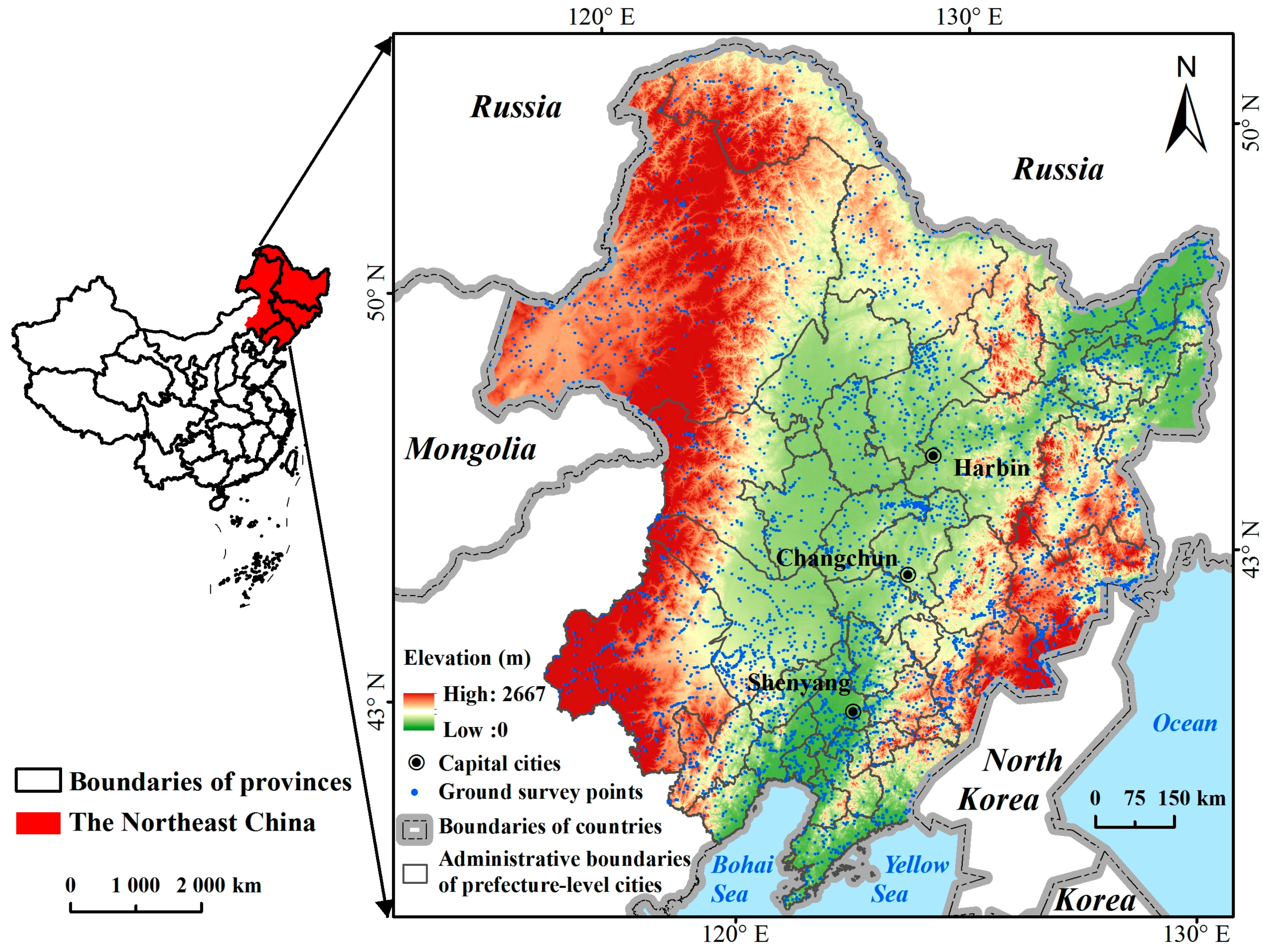
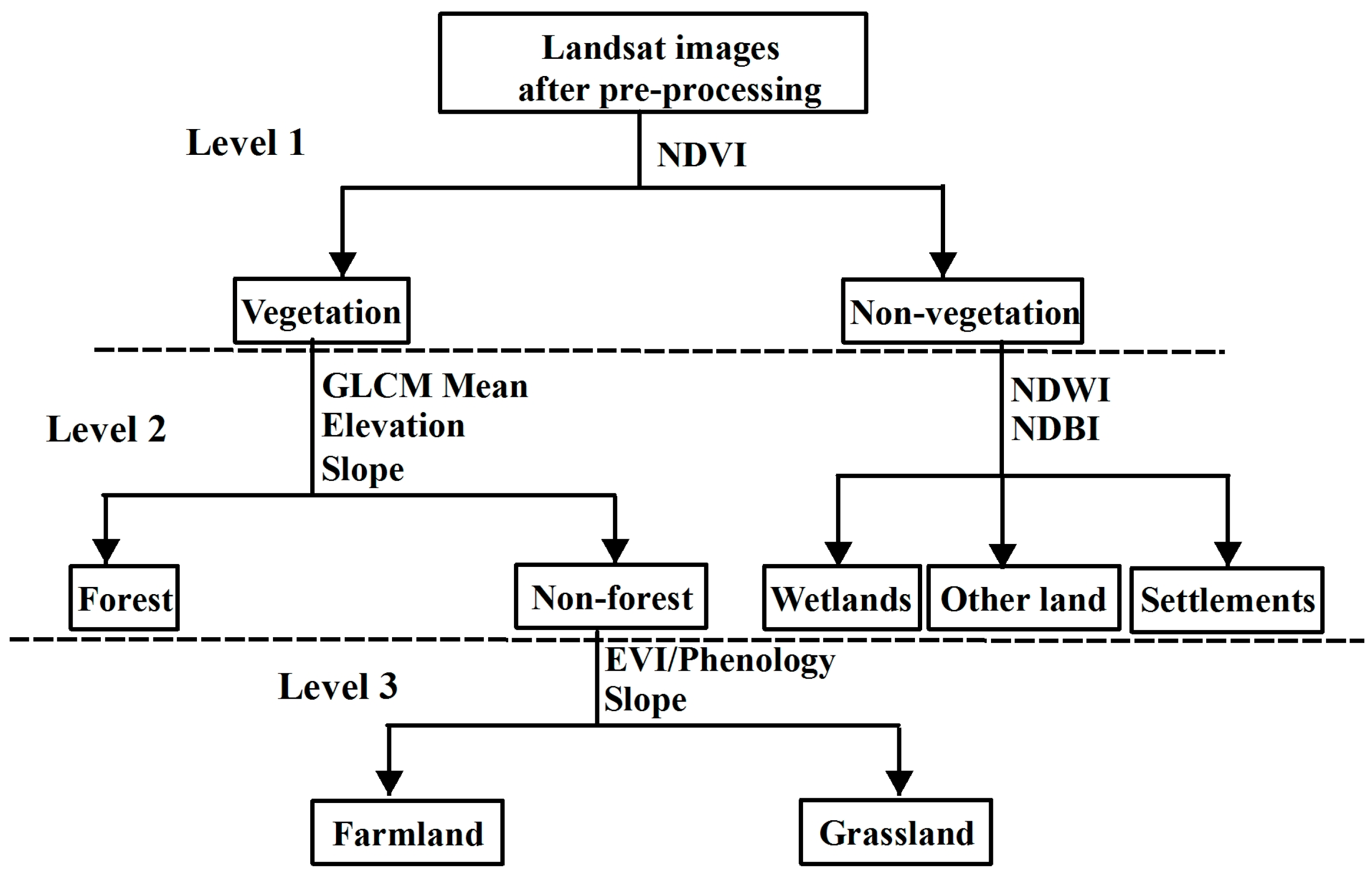

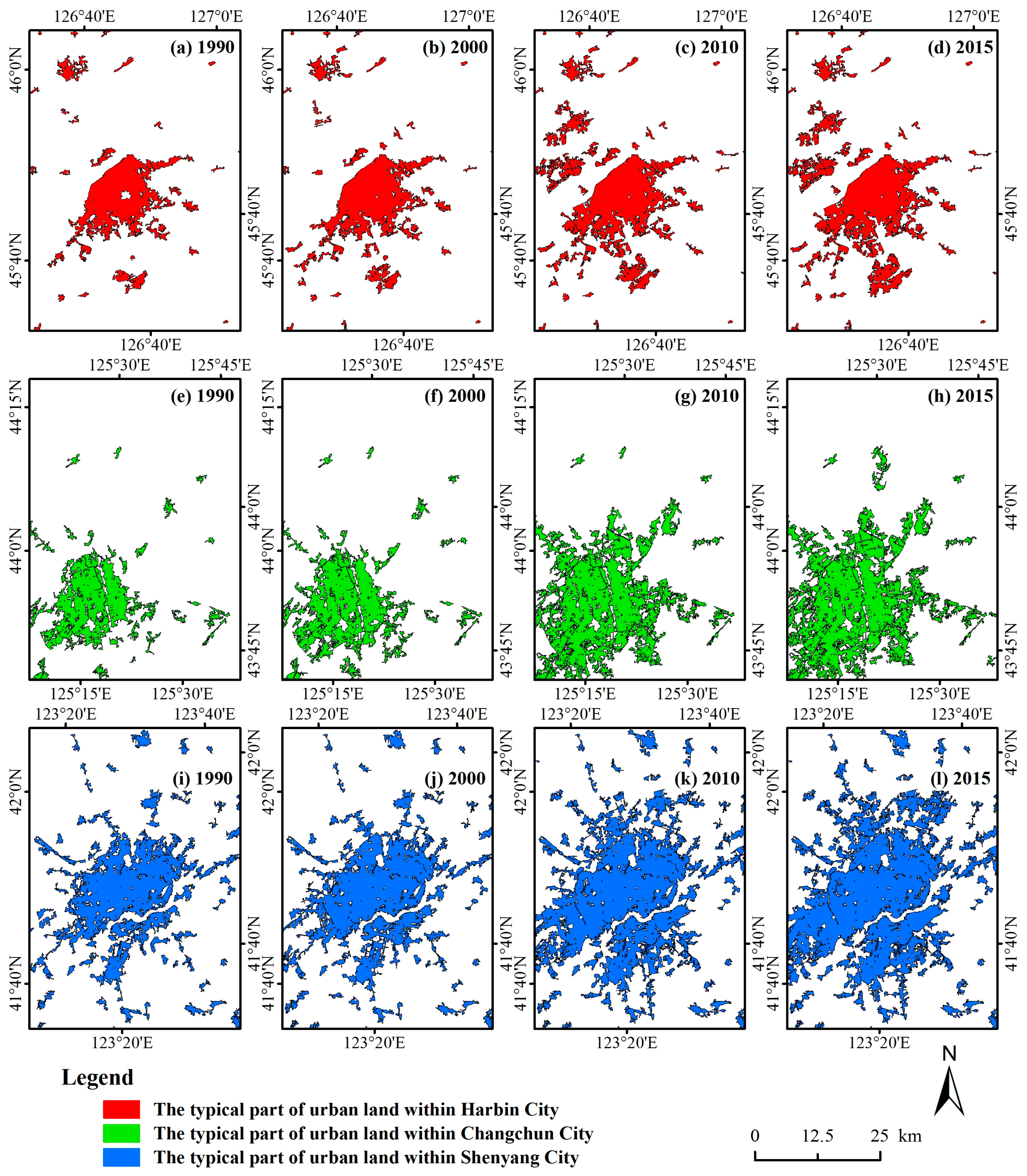
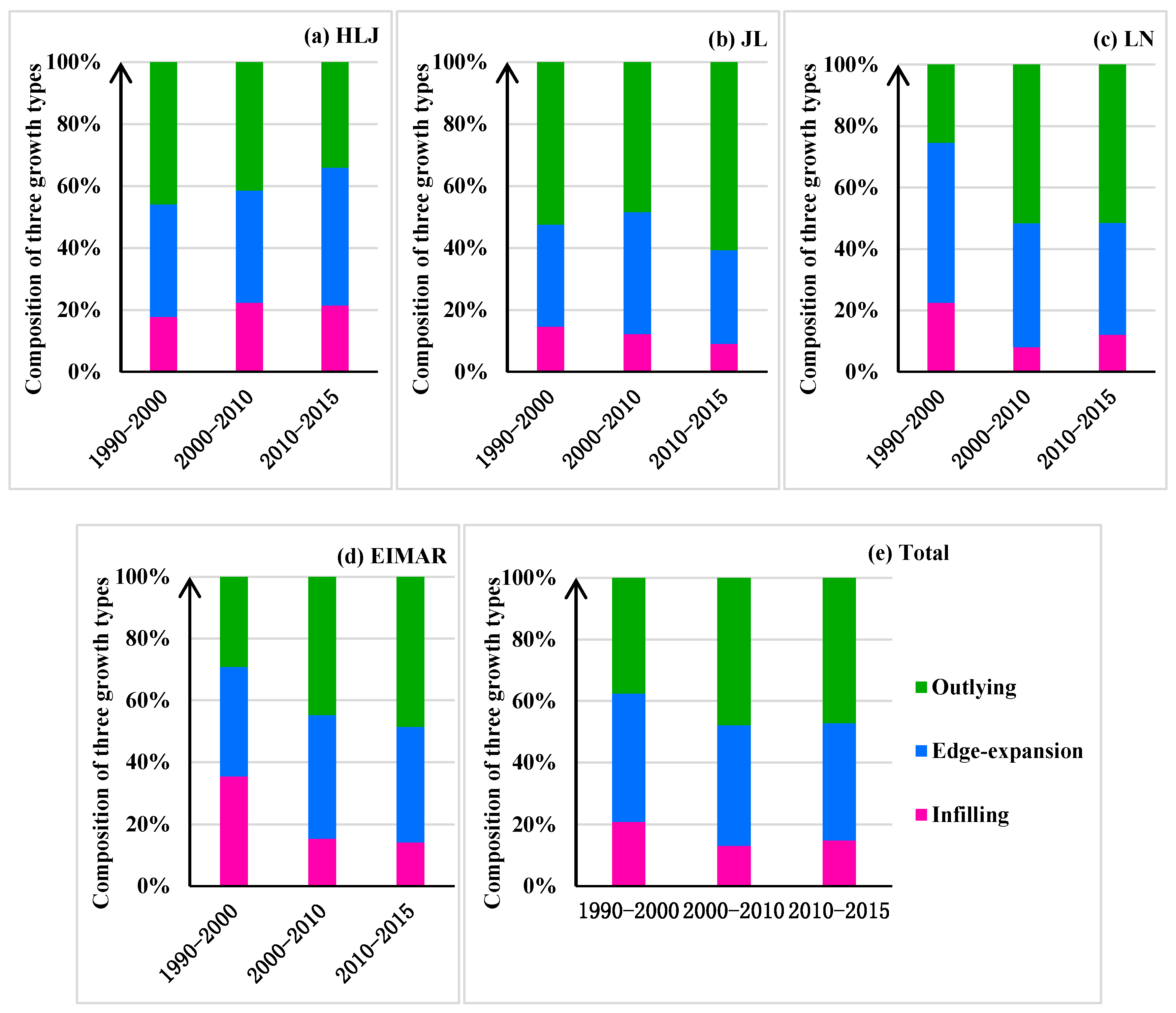
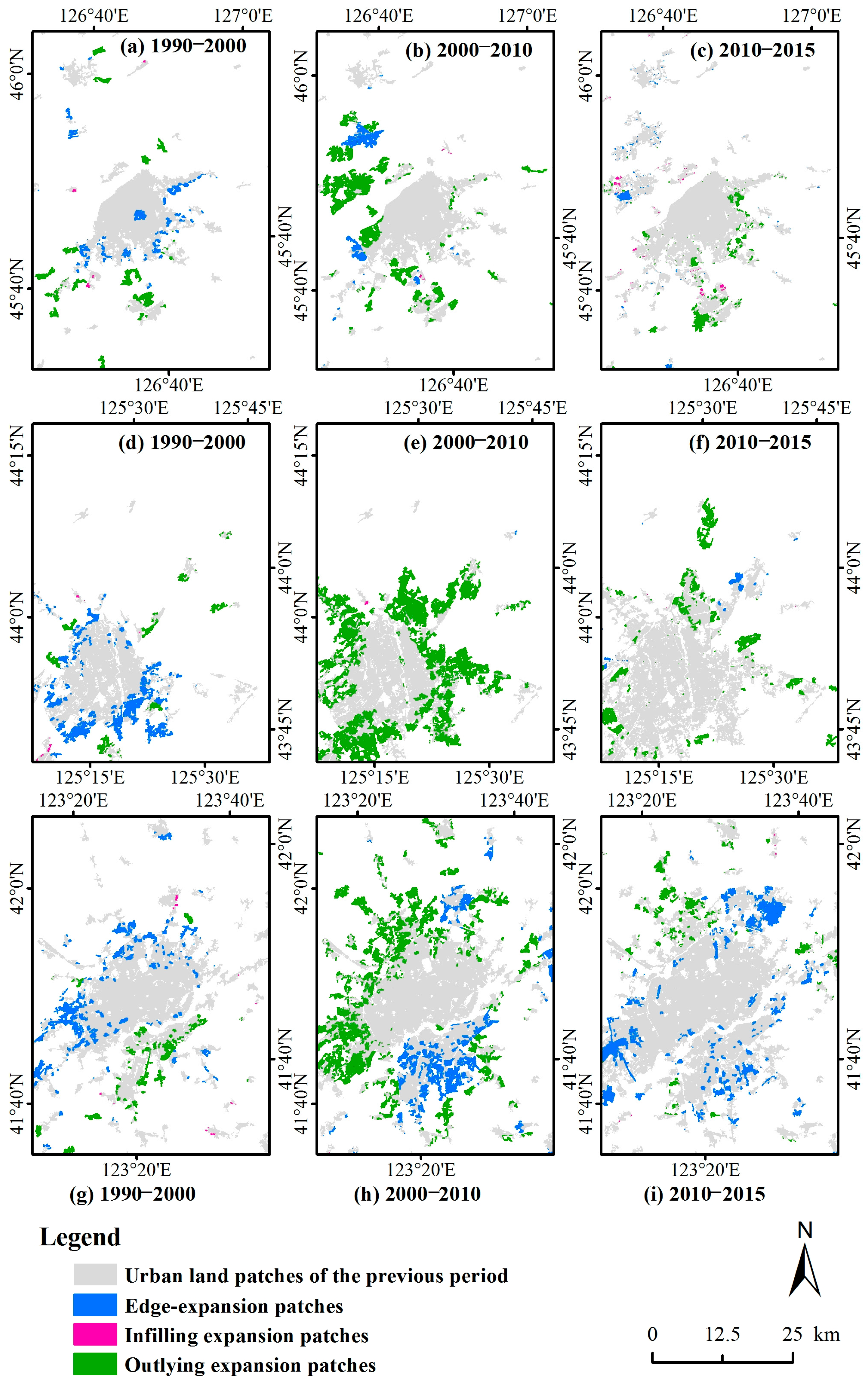
| Parameter | Level 1 | Level 2 | Level 3 |
|---|---|---|---|
| Scale | 50 | 30 | 10 |
| Shape | 0.3 | 0.2 | 0.1 |
| Compactness | 0.4 | 0.4 | 0.4 |
| Statistical Data Related to Urban Land (km2) | r |
|---|---|
| Total population (104 persons) | 0.76 ** |
| Urban population (104 persons) | 0.64 ** |
| Gross domestic product (100 million Yuan) | 0.78 ** |
| Secondary industry product (100 million Yuan) | 0.77 ** |
| Tertiary industry product (100 million Yuan) | 0.78 ** |
| Per capita gross domestic product (Yuan) | 0.48 ** |
| Floor space of buildings under construction in commercial house (104 m2) | 0.73 ** |
| Per capita disposable income of urban permanent residents (Yuan) | 0.33 ** |
| Gross output value of construction industry (104 Yuan) | 0.60 ** |
| Year | Formula | Adjusted R2 |
|---|---|---|
| 1990 | UL = −0.32 **UP + 49.31 **GDP − 12.48 **SIP − 1.92 **PCGDP − 2.20PCDIUPR + 13.63 *GOVCI + 0.10 ** | 0.86 ** |
| 2000 | UL = 0.14TP + 2.61 **FSBCCH + 8.17 *GOVCI + 0.05 * | 0.81 ** |
| 2010 | UL = 0.37 **TP − 0.45UP + 0.29 *SIP + 2.00 **TIP − 3.28 *GOVCI + 0.08 * | 0.85 ** |
| 2015 | UL = 3.39 *GDP − 0.95SIP − 2.04 *TIP + 0.30FSBCCH + 0.25GOVCI + 0.04 | 0.86 ** |
| General | UL = 0.33 **TP + 0.13 *UP − 1.22GDP + 0.98 **SIP + 0.86 *TIP + 0.04 ** | 0.79 ** |
© 2018 by the authors. Licensee MDPI, Basel, Switzerland. This article is an open access article distributed under the terms and conditions of the Creative Commons Attribution (CC BY) license (http://creativecommons.org/licenses/by/4.0/).
Share and Cite
Chen, L.; Ren, C.; Zhang, B.; Wang, Z.; Liu, M. Quantifying Urban Land Sprawl and its Driving Forces in Northeast China from 1990 to 2015. Sustainability 2018, 10, 188. https://doi.org/10.3390/su10010188
Chen L, Ren C, Zhang B, Wang Z, Liu M. Quantifying Urban Land Sprawl and its Driving Forces in Northeast China from 1990 to 2015. Sustainability. 2018; 10(1):188. https://doi.org/10.3390/su10010188
Chicago/Turabian StyleChen, Lin, Chunying Ren, Bai Zhang, Zongming Wang, and Mingyue Liu. 2018. "Quantifying Urban Land Sprawl and its Driving Forces in Northeast China from 1990 to 2015" Sustainability 10, no. 1: 188. https://doi.org/10.3390/su10010188







